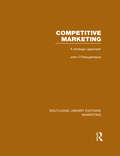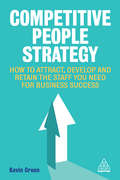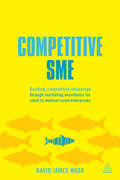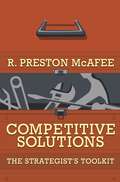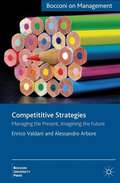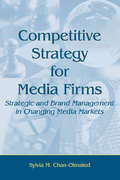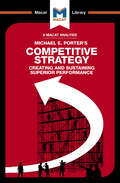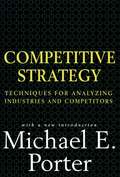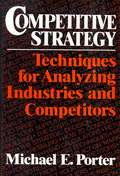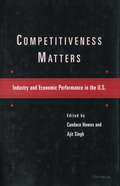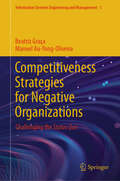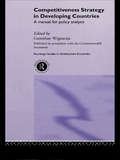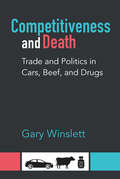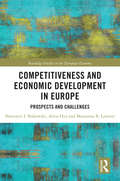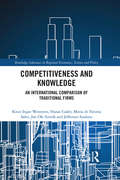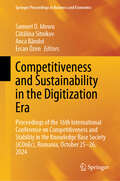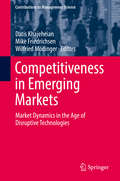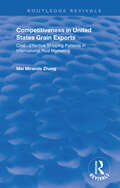- Table View
- List View
Competitive Manufacturing: New Strategies for Regional Development
by Stuart A. RosenfeldStuart A. Rosenfeld presents a timely analysis of the problems the United States and other industrialized countries face as they adjust from economies based on natural resources and goods to economies based on quality of human resources and high-performance, market-oriented organizations. Some of the questions raised include: Will American industry successfully face the competitive challenge of the global economy? Can US manufacturing raise productivity and innovate enough to remain healthy? Have the latest advances in process technology and management practice penetrated the rural industrial base? How can public policy help improve the competitiveness of the crucial manufacturing sector?This book challenges the conventional wisdom in economic development policy. Past state and local industrial policy focused on locational decisions, not on issues of competitiveness. Building the competitive advantage of industry is more important than promoting the competitive advantages of location. Incentives to modernize are more important than subsidies to locate.Competitive Manufacturing uses the rural South, the most industrialized rural region of the nation, to examine the strengths and weaknesses of manufacturing as the basis for economic growth. Using historical analysis, surveys, and intensive case studies, the author analyzes the technological capabilities of rural manufacturing, the factors that influence the decision to modernize, and the effects of technology on education and work. Comparative studies in Denmark and Italy point to new directions for US economic development policy.
Competitive Marketing: A Strategic Approach (Routledge Library Editions: Marketing)
by John O'ShaughnessyThis volume is a text-book for students of marketing, providing a basic understanding of the concept and techniques of marketing. It shows how basic background information relating to the UK market may be integrated into business planning and how information from other sources should be incorporated and used.
Competitive People Strategy: How to Attract, Develop and Retain the Staff You Need for Business Success
by Kevin GreenIn order to achieve sustainable competitive advantage, businesses need to unlock the skills, talent and capabilities of their people, both individually and collectively. While many business and leaders recognise this, they have until now lacked a strategic approach to achieving it. Competitive People Strategy is a comprehensive roadmap showing how businesses can connect their human potential to their bottom line, and provides step-by-step guidance on how to create, test and measure a differentiated people strategy. Featuring tips and checklists throughout, it explores the core building blocks of leadership and organizational culture, as well as employee experience and engagement. It also examines the roles of effective talent attraction and management, and how to lead change and transformation. Central to the book is the importance of moving HR from a support function to becoming a creator of value and driver of business success.Drawing upon insights from organizations including Royal Mail and Starbucks, as well as interviews with senior HR leaders, Competitive People Strategy is an essential guide to developing a people strategy which creates a purpose-driven culture, provides greater value to customers and achieves superior business results.
Competitive Quality Strategy
by Pierre MaillardThis book succinctly presents new methodological principles that will help you raise the quality of your valuable production to enhance your competitiveness. The concepts and models of principles of actions presented result from over 20 years of the author observing the ways in which companies of all sizes and in all sectors use specific mechanisms of quality production to give rise to long-lasting competitive factors. You’ll find practical guides that will help you better understand and strengthen your approaches to create new competitive edges, based on your employees’ culture of quality.
Competitive SME
by David James HoodCompetitive SME is a comprehensive guide to grasping the competitive and marketing opportunities facing small to medium size enterprises today. Inspired and driven by the EU initiative futureSMETM, it gives essential advice on how, by implementing a clear and focused strategy and using simple tools, you can survive, thrive, and compete. It outlines a simple yet effective model that will allow you to: create and manage effective marketing and branding processes; better engage with your market , creating and projecting real value; increase your worth to the market with corresponding increase in revenue; maximise your resources, however limited; ensure that your competitive edge and U.S.P. is amplified and sustained. Packed with simple but effective tools, Competitive SME is an essential, practical handbook for any manager or owner of an SME / SMB who wants to outperform their competitors.
Competitive Solutions: The Strategist's Toolkit
by R. Preston McAfeeCompetitive Solutions is an entertaining and wideranging introduction to successful business methods applied to a variety of real-world situations. Rejecting the one-size-fits-all premise that underlies so many guides to business strategy, Preston McAfee develops the intellectual tools and insights needed to confront many marketplace problems. Drawing on his broad experience as a consultant for major U.S. companies, as well as extensive research, McAfee emphasizes cooperation, pricing, litigation, and antitrust as vital to a firm's competitive posture--and focuses more attention on these elements than do most business strategy accounts.McAfee begins by considering strategy as successfully applied by America OnLine, an example that introduces many of the tools discussed in greater depth throughout the book. From here he moves to industry analysis: By examining the context for developing a strategy, he points out uses of positioning and differentiation that enable a firm to weaken price competition and deter rivals from stealing customers. McAfee's exploration of a product's life cycle proves an invaluable guide to positioning new technology in order to maximize the potential for future customers.In the centerpiece of the book, McAfee lays out a how-to manual for cooperation, providing tactics crucial for setting standards, lobbying the government, and fostering industry growth. Writing in a conversational manner, McAfee also addresses such deep topics as organizational design and employee compensation and incentives. More detailed discussions examine antitrust enforcement, which is an increasingly important constraint on strategy, as well as strategies for pricing, bidding, signaling, and bargaining.This book is a fascinating examination of modern business strategy and its application in many different settings. Students of business and economics--as well as executives and managers--will recognize Competitive Solutions as an indispensable resource as well as a definitive vision of the strategic firm: one in which each element of company strategy reinforces the other elements.
Competitive Strategies
by Enrico Valdani Alessandro Arbore'If we want things to stay as they are, things will have to change. ' from the Italian novel The Leopard, is the starting point of this book which proposes a new framework to effectively manage offensive and defensive marketing strategies. It reinterprets the competitive challenge as a circular journey, that is, an endless sequence of three competitive 'seasons'. The authors call them the games of movement, imitation, and position. Competitive seasons and their most effective marketing maneuvers are fully discussed with the support of figures, incidents, and almost 100 international examples. Altogether, almost 50 offensive and defensive strategies are presented. The book provides the reader with both managerial tools and strategic marketing vision to manage the present while designing the future.
Competitive Strategies for Small and Medium Enterprises: Increasing Crisis Resilience, Agility and Innovation in Turbulent Times
by Klaus North Gregorio VarvakisThis bookis a timely guide for Small and Medium Enterprise (SME) researchers, policymakers and strategists. SMEs are the most important sources of job creation andlocal development especially in knowledge-based economies. As turbulence in theglobalized economies expands SMEs will have to learn to sustain competitivenessby developing their 'dynamic capabilities'. Based on the findings of a 4-yearEuropean and Latin American research project, this book provides a theoreticalframework, practical instruments and cases on how SMEs in diverse economic,social and cultural contexts can develop crisis resilience, increase agility,innovate and thus successfully compete in turbulent times.
Competitive Strategy for Media Firms: Strategic and Brand Management in Changing Media Markets (Routledge Communication Series)
by Sylvia M. Chan-OlmstedCompetitive Strategy for Media Firms introduces the concepts and analytical frameworks of strategic and brand management, and illustrates how they can be adapted according to the characteristics of distinct media products. Working from the premise that all media firms must strategize in response to the continuing evolution of new media, author Sylvia M. Chan-Olmsted offers applications of common business approaches to the products and components of the electronic media industry, and provides empirical examinations of broadcast, multichannel media, enhanced television, broadband communications, and global media conglomerate markets. This insightful and timely volume provides a thorough review of current concepts and industry practices, and serves as an essential primer for the application of business models in media contexts. As a realistic and integrated approach to media industry studies, this volume has much to offer researchers, scholars, and graduate students in media economics and management, and will be an important reference for industry practitioners.
Competitive Strategy in International Construction
by John D. Macomber Emrah ErgelenConstruction of buildings and infrastructure is one of the largest industries in the world in terms of volume. It is also one of the most physically risky, financially uncertain, and politically impacted. The industry is highly fragmented since there are few economies of scale, substantial location advantages, and almost all of the work is site built from unique plans. In order to achieve long term above average returns on effort and on invested capital, it's crucial that firms plan with intent with respect to markets and clients served, services provided, roles played in the industry value added system, and the matching of skills and assets to opportunities. The longest lived firms also determine which markets, products, customer types, and roles to avoid even when there might be attractive short term opportunistic contracts to be pursued. This note covers both the idiosyncratic nature of this industry that makes many classic strategic planning tools unhelpful, and also details the specific steps strategists should follow to gain the benefits and avoid the pitfalls of competition in this industry.
Competitive Strategy: Creating and Sustaining Superior Performance
by Pádraig BeltonMichael E. Porter’s 1980 book Competitive Strategy is a fine example of critical thinking skills in action. Porter used his strong evaluative skills to overturn much of the accepted wisdom in the world of business. By exploring the strengths and weaknesses of the accepted argument that the best policy for firms to become more successful was to focus on expanding their market share, he was able to establish that the credibility of the argument was flawed. Porter did not believe such growth was the only way for a company to be successful, and provided compelling arguments as to why this was not the case. His book shows how industries can be fragmented, with different firms serving different parts of the market (the low-price mass market, and the expensive high-end market in clothing, for example) and examines strategies that businesses can follow in emerging, mature, and declining markets. If printing is in decline, for example, there may still be a market in this industry for high-end goods and services such as luxury craft bookbinding. Porter also made excellent use of the critical thinking skill of analysis in writing Competitive Strategy. His advice that executives should analyze the five forces that mold the environment in which they compete – new entrants, substitute products, buyers, suppliers, and industry rivals – focused heavily on defining the relationships between these disparate factors and urged readers to check the assumptions of their arguments. Porter avoided technical jargon and wrote in a straightforward way to help readers see that his evaluation of the problem was strong. Competitive Strategy went on to be a highly influential work in the world of business strategy.
Competitive Strategy: Techniques for Analyzing Industries and Competitors
by Michael E. PorterPorter's Competitive Strategy has transformed the theory, practice, and teaching of business strategy throughout the world. In its simplicity Porter's analysis of industries captures the complexity of industry competition in five underlying forces.
Competitive Strategy: Techniques for Analyzing Industries and Competitors (Review Book Ser.)
by Michael E. PorterNow nearing its 60th printing in English and translated into nineteen languages, Michael E. Porter's Competitive Strategy has transformed the theory, practice, and teaching of business strategy throughout the world. Electrifying in its simplicity -- like all great breakthroughs -- Porter's analysis of industries captures the complexity of industry competition in five underlying forces. Porter introduces one of the most powerful competitive tools yet developed: his three generic strategies -- lowest cost, differentiation, and focus -- which bring structure to the task of strategic positioning. He shows how competitive advantage can be defined in terms of relative cost and relative prices, thus linking it directly to profitability, and presents a whole new perspective on how profit is created and divided. In the almost two decades since publication, Porter's framework for predicting competitor behavior has transformed the way in which companies look at their rivals and has given rise to the new discipline of competitor assessment. More than a million managers in both large and small companies, investment analysts, consultants, students, and scholars throughout the world have internalized Porter's ideas and applied them to assess industries, understand competitors,, and choose competitive positions. The ideas in the book address the underlying fundamentals of competition in a way that is independent of the specifics of the ways companies go about competing. Competitive Strategy has filled a void in management thinking. It provides an enduring foundation and grounding point on which all subsequent work can be built. By bringing a disciplined structure to the question of how firms achieve superior profitability, Porter's rich frameworks and deep insights comprise a sophisticated view of competition unsurpassed in the last quarter-century.
Competitive Supply Chains: A Value-Based Management Perspective
by Enver YücesanThis timely and highly relevant book refocuses the discussion on supply chain innovation for an era of unprecedented challenges and opportunities in global supply chain operations. This third edition builds upon the ideas explored by the author in Competitive Supply Chains (2007, 2016), featuring new content and analysis, new case studies and a complete reassessment on the impact of new technologies, ESG requirements, and geopolitical challenges.Featuring case studies from European and Asian companies, this book is an essential resource for researchers and students of supply chain and operations management.
Competitiveness Matters: Industry and Economic Performance in the U.S.
by Candace Howes Ajit SinghThis book argues, against the current view, that competitiveness--that is, the competitiveness of the manufacturing sector--matters to the long-term health of the U. S. economy and particularly to its long-term capacity to raise the standard of living of its citizens. The book challenges the arguments popularized most recently by Paul Krugman that competitiveness is a dangerous obsession that distracts us from the question most central to solving the problem of stagnant real income growth, namely, what causes productivity growth, especially in the service sector. The central argument is that, if the U. S. economy is to achieve full employment with rising real wages, it is necessary to enhance the competitiveness of its tradable goods sector. The book shows that current account deficits cannot be explained by macroeconomic mismanagement but are rather the consequence of an uncompetitive manufacturing sector. It finds that the long-term health of the manufacturing sector requires not only across-the-board policies to remedy problems of low or inefficient investment, but also sectoral policies to address problems that are strategic to resolving the balance of payments problems. Lessons are drawn from the experience of some European and Asian countries. This book will be of interest to economists, political scientists, and business researchers concerned with the place of the manufacturing sector in overall health of the U. S. economy, with issues of industrial policy and industrial restructuring, and with the conditions for rising standards of living. Candace Howes is Associate Professor, Barbara Hogate Ferrin Chair, Connecticut College. Ajit Singh is Professor of Economics, Queens College, Cambridge.
Competitiveness Strategies for Negative Organizations: Challenging the Status Quo (Information Systems Engineering and Management #1)
by Beatriz Graça Manuel Au-Yong-OliveiraThe book aims to describe how a certain type of organisation may come into existence and may even become prevalent in society - what we call a negative organisation. This type of organization is one where the status quo prevails over what is best for the company, in strategic terms. Namely, certain employees who are actually very good may be forced to leave so as to not disturb the status quo and existing loyalties and ties which are actually prejudicial to the company, in the medium to long run. Change is very necessary and strategies need to change to accompany technological breakthroughs and other market developments. Wanting to maintain the same course so as not to “disrupt the waters” is often a bad strategy and the firm will suffer. Innovation must prevail over the maintenance of the status quo or, in other words, must prevail over the maintenance of the existing state of things and hierarchy. Our book discusses the topic as well as providing solutions for the situation of a firm becoming negative. Various levels of leadership in the organisation may contribute to a negative organisation and this too is discussed. We hope to have contributed in whatever small way to a more joyous, satisfactory and, above all, more productive and innovative workplace.
Competitiveness Strategy in Developing Countries: A Manual for Policy Analysis (Routledge Studies in Development Economics)
by Ganeshan WignarajaGlobalization and structural adjustment offer many opportunities for export orientated industrialization in developing economies. As a group, competitiveness in the developing countries has improved, but, while East Asian economies have had rapid export growth and technological upgrades, South Asian and African economies have lagged behind. Old structures, institutions, behavioural patterns and public policies are ill-adapted to deal with the challenges posed by technological change and economic liberalization. Consequently there is an urgent need for change in government and private sector attitudes and strategies.This volume seeks to generalise the lessons across developing country and enterprise cases, and sheds light on which trade and industrial strategies and instruments work best, and which do not work, in relation to manufacturing competitiveness.
Competitiveness and Corporate Culture (Routledge Revivals)
by Hideo YamashitaPublished in 1998. Rapidly advancing information technology plays an important role in the formation of new corporate organizations. Some people say, in fact, that the Internet itself may well suggest a future corporate organization. Under these circumstances, how is the corporate culture, which is integral to the organization, to be duly taken? What is an appropriate culture to the would-be future business organization, which will necessarily be all the more supported and strengthened by information technology? In the author's view, the cultures fit in well with the structure of enterprise competitiveness can readily evolve into the 21st century organization. Such a culture would, with no difficulty, find an arena of its own in the future organization and eventually become integral to the company.
Competitiveness and Death: Trade and Politics in Cars, Beef, and Drugs
by Gary WinslettCompetitiveness and Death examines the increase and reduction of regulatory barriers to trade across three industries: environmental, labor, and safety rules on automobiles, consumer protection regulations on meat, and intellectual property regulations on medicines. The fundamental negotiation in trade and regulatory policymaking occurs between businesses, activists, and government officials. Gary Winslett builds on new trade theories to explain when and why businesses are most likely to lobby governments to reduce these regulatory trade barriers. He argues that businesses prevail when they can connect with broader concerns about national economic competitiveness. He examines how activist organizations overcome collective action problems and defend regulatory differences, arguing that they succeed when they can link their desire for barriers with preventing needless death. Competitiveness and Death provides a political companion to new trade theories in economics, questioning cleavage-based explanations of trade politics, demonstrating the underappreciated importance of activists, suggesting the limits of globalization, providing in-depth examination of previously ignored trade negotiations, qualifying the California Effect (the shift toward stricter regulatory standards), and showing the relative rarity of regulations used as disguised protectionism.
Competitiveness and Economic Development in Europe: Prospects and Challenges (Routledge Studies in the European Economy)
by Slawomir I. Bukowski, Alina Hyz and Marzanna B. LamentThe success of an economy to adapt quickly, flexibly, and effectively to the demands of the changing international economic environment can only be investigated using the achievements of other national economies or regions as a benchmark. This book analyzes the fundamental factors of competitiveness, which will, in turn, facilitate economic development and growth, in the new post-crisis environment. In the economic, social, legal, and technological environment that has emerged in recent years, as well as in the period after the recent financial crisis, it is critical to define, assess, and implement new pathways to competitiveness and economic development. The book covers all aspects of competitiveness and economic growth, from financial intermediaries to tourism and the digital economy, and from regulation and corporate governance to exchange rate dynamics and monetary policy issues. It uses empirical findings from a variety of different countries with divergent economic structures and policies. It examines the new system of production, and the technological, commercial, financial and institutional environment, with the aim of recommending a proportional division of benefits and costs of economic growth. It offers a fresh, holistic, and flexible concept to underscore the new relationship between competitiveness and economic growth. Such an approach is needed, whereby competitiveness is no longer a zero-sum game between countries, but is achievable for all countries. The book recommends future directions and offers policy solutions, and as such, will appeal to students, researchers, and policymakers, as well as those interested in the role of competitiveness in the operation of markets, productivity, and economic development, and how it might foster innovation and growth.
Competitiveness and Growth in Brazilian Cities: Local Policies and Actions for Innovation
by Ming Zhang'Competitiveness and Growth in Brazilian Cities' addresses the question of what cities can do to improve economic performance and create jobs. The topic is explored through a review of theories and policy options for city competitiveness, preliminary benchmarking of Brazilian cities, and case studies of two urban areas in Northeast Brazil-the Cariri region, Ceará and São Luís, Maranhão. The book concludes that to be competitive, cities need to reduce the cost of doing business by improving their services and infrastructure and by reducing bureaucracies. But for a middle-income country such as Brazil, which needs to be economically competitive in a globalized environment, this is not sufficient. Cities also need to add value to local businesses. A crucial part of their strategy should be to create and sustain an environment that stimulates local firms to innovate and learn from each other, to nurture the creation of synergies generated by the interconnected economic clusters in the city, and to provide incentives for all local players to continuously upgrade their level of competitiveness. With regard to local policy actions, this book highlights the cluster approach to competitiveness, with its focus on facilitating private-sector collaborations for collective efficiency. 'Competitiveness and Growth in Brazilian Cities' provides many examples of actions that may be undertaken at the local level, emphasizing the critical importance for cities to pursue a unique strategy based on their comparative and competitive advantages.
Competitiveness and Knowledge: An International Comparison of Traditional Firms (Routledge Advances in Regional Economics, Science and Policy)
by Knut Ingar Westeren Hanas Cader Maria de Sales Jan Ole Similä Jefferson StadutoIn the twenty-first century technology has become global, and firms compete using knowledge and capital. The ‘traditional firm’ has a need for innovation and depends on efficient knowledge management to improve productivity. This book examines five firms that produce the same commodity, white chicken meat, in different parts of the world and under very different conditions. It brings to bear the expertise and international perspectives of the author team, utilizing theoretical discussions and case studies to address the question: How do local firms use knowledge to compete in an increasingly globalized world? This book will be of interest to any postgraduate student, researcher or policymaker hoping to achieve a firmer grasp of innovation and knowledge management: a recurring and highly pertinent theme in contemporary economics.
Competitiveness and Sustainability in the Digitization Era: Proceedings of the 16th International Conference on Competitiveness and Stability in the Knowledge Base Society (iCOnEc), Romania, October 25—26, 2024 (Springer Proceedings in Business and Economics)
by Samuel O. Idowu Ercan Özen Cătălina Sitnikov Anca BăndoiThis book analyzes digital transformation in organizations through digital strategy, digital capability, and digital culture. Featuring contributions presented at the 16th International Conference on Competitiveness and Stability in the Knowledge Base Society (iCOnEc), the book explores the influence of digital transformation which has on companies&’ sustainability and competitiveness, particularly in times of economic uncertainty.Megatrends like digitalization are reshaping society and the economy. In an ever-evolving world, businesses play a crucial role in enabling society to carry out digital transformation and engage in competitive and sustainable growth to improve performance as well as socioeconomic and environmental sustainability. The enclosed chapters examine the relationship and mechanisms connecting digital transformation to ongoing business growth.Presenting both conceptual and operational perspectives on emerging issues, this book is useful for researchers, scholars, students, and policymakers in digital transformation and organizational sustainability and competitiveness.
Competitiveness in Emerging Markets: Market Dynamics In The Age Of Disruptive Technologies (Contributions To Management Science Series)
by Wilfried Mödinger Mike Friedrichsen Datis KhajeheianThis book presents a collection of interrelated research advances in the field of technological entrepreneurship from the perspective of competition in emerging markets. Featuring contributions by scholars from different fields of interest, it provides a mix of theoretical developments, insights and research methods used to uncover the unexplored aspects of competitiveness in emerging markets in an age characterized by disruptive technologies.
Competitiveness in United States Grain Exports: Cost-Effective Shipping Patterns in International Rice Marketing
by Mei M. ZhangFirst Published in 1996. The United States is one of the major grain producing and exporting countries in the world. The grain provides economic livelihood for many millions of farm families in the world and those engaged in marketing and distribution. Rice is a major crop for the United States in international grain trade though it is not a major crop for consumption. One of the questions the U.S. grain industry has been facing is the question of how to keep its appropriate share in the world market. The purpose of this book is to determine the cost per ton of shipping rice for selected sizes of bulk vessels from various U.S. southern ports of origin to specific foreign import ports. These cost data are then used in a transportation model to estimate a least-cost shipping pattern for U.S. rice exports

